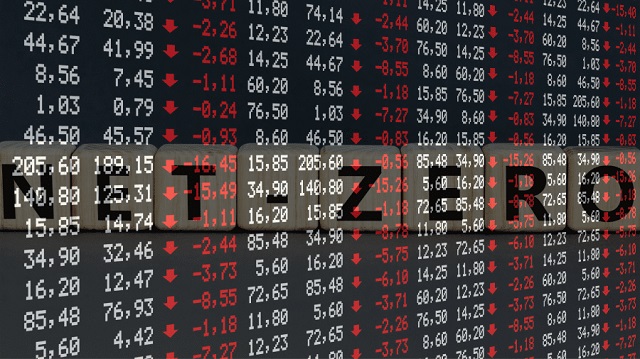Economy
Feds ‘net-zero’ agenda is an anti-growth agenda

From the MacDonald Laurier Institute
By Chris Sankey
Canada’s goal should not be to eliminate fossil fuels, but to carry out a steady and manageable reduction of emissions
The federal government is pushing an aggressive emissions reduction strategy that could devastate the Canadian economy and threaten our way of life. This isn’t just about the oil & gas industry. Port-related industries, transportation, infrastructure, health and education, and countless other sectors will be collateral damage. As will the standard of living of everyday Canadians.
One need only peek behind the curtain to understand the current course of federal policy.
Ottawa’s anti-fossil fuels agenda appears to be rooted in the ideas of two ideologically driven behind-the-scenes entities: Senators for Climate Solutions (SFCS) and Clean Energy Canada (CEC).
A group of 44 Canadian Senators, led by Sens. Mary Coyle and Stan Kutcher (both of Nova Scotia), launched SFCS in the fall of 2022. The Senators also recruited a team of interns from GreenPAC, a Toronto-based environmental lobby group, to help get SFCS up and running. GreenPAC Executive Director Sarah Van Exan told blog The Energy Mix at the time that the group had recently assigned its first-ever Senate intern to the office of Sen. Coyle.
“We saw the chance to lend critical capacity—with communication, coordination, and policy research—to help them get established,” Van Exan told The Energy Mix in an email. “The group’s cross-partisan aim and determination to put a climate lens on legislation, advance climate solutions, and hold the government’s feet to the fire is exciting.”
This team of ‘climate-minded’ Senators draws lightly on expertise from Western Canada, let alone calling on experienced energy experts from Alberta. Of the dozen experts listed on the SFCS website, just two – University of Calgary Geosciences professor Sara Hastings-Simon and Vancouver Island farmer Andrew Rushmere – are based in Western Canada.
12 years earlier, Clean Energy Canada was established as a subsidiary of the Morris J. Wosk Centre for Dialogue at Simon Fraser University (SFU) in Burnaby, BC. The group is the brainchild of Merran Smith, a figure The Province once described as “the spawn of the tendrilous and pervasive eco-activist group Tides Canada and [SFU].” Smith first came to prominence in the early 2000s while campaigning to protect coastal BC’s Great Bear Rainforest, rubbing elbows with the likes of Tzeporah Berman (an anti-pipeline acticist so extreme she was booted from the Alberta NDP’s Oil Sands Advisory Group). Other members of the team include BC Green Party alum Evan Pivnick and Electric Vehicle (EV) evangelist Meena Bibra. According to its own website, CEC’s mission is to “accelerate the transition to a renewably powered economy” via “inform[ing] policy leadership.”
Are these the sorts of people the Trudeau Government should be listening to on climate matters?
Let me give you a few stats and you be the judge. I recently had a chance to listen to Adam Waterous, the CEO of the Waterous Energy Fund and former Global Head of Investment Banking at Scotia Waterous. He is, I may add, an incredibly intelligent businessman who lives and breathes energy.
Adam shared some surprising facts about EVs. For instance, he mentioned that it takes five times the amount of oil to build an EV than it does to build a conventional gas-powered vehicle. In order offset this difference, a person must drive an EV 120,000 kms using the electrical grid. Meaning, every time we build an EV demand for oil goes up, not down. Further, an EV battery does not last the lifetime of the vehicle itself, crapping out in as little as 8 years. This expands the EV’s carbon footprint even further as producing a single EV-grade battery emits over seven tonnes of C02e emissions. All told, an EV has roughly double the production footprint of a conventional vehicle.
Still convinced we are saving the planet?
The BC provincial government is forging ahead with a set of policies that its own modelling shows will make BC’s economy $28 billion smaller in 2030 than it would be absent these policies. (To put this number into context, this is roughly what the province spends on health care each year). This will set prosperity back more than a decade. This remarkable finding emerges from looking beyond the government’s glossy reports to the raw modelling results of the estimated economic impact of CleanBC policies that are studiously ignored in its public communication materials.
Similarly, Alberta Electric System Operator (AESO) estimates the cost of achieving a net zero electricity grid by 2050 to be nearly $200 billion, while the AESO Net-Zero Emissions Pathways report estimates that accelerating this timeline to 2035 could add an extra $45 to $52 billion. (That is without factoring in the costs of co-generation or the full distribution system and integration costs). Moving to net zero by 2050 will also eliminate 10,000 direct jobs in the oil and gas sector and an estimated 2.7 million jobs in total.
All provinces, and every Canadian household, will be impacted by the federal emissions reduction strategy. However, no province will be impacted more than Alberta. The currently federal modelling used to develop the clean electricity regulations (CER) does not properly represent Alberta’s Electricity Market and thus is unable to adequately forecast the economics of energy production. Canada’s proposed emissions intensity limit effectively requires natural gas backed power plants to sequester an annual average of 95% of all associated emissions through CCUS or other technologies (CCUS) or other technologies. As of writing, no natural gas generation with CCUS modifications has ever hit this mark.
The CERs create significant investment risk for (CCUS) projects as the physical standard for the technology is unproven. Adding insult to injury, the federal government is proposing a 20-year end-of-life for natural gas facilities built prior to January 2025. This will result in some of the cleanest gas plants in the world being shut down decades before they run their useful life; all while Asia continues to burn coal at a record pace.
Canada is about to enter a world of self-inflicted economic pain at precisely the time that Indigenous communities are finally starting harness their resource wealth. We finally made it to the corporate table where we have a seat, a say and ownership – and now the federal government wants to take it all away. How is that for bad timing?
Without reliable and affordable energy, Canadians will be left choosing between shelter, food and keeping the lights on. I don’t know about you, but I will not follow those politicians and organizations driving our climate policies to extremes, into ankle deep water, but I will listen to and follow serious people like Adam Waterous.
The goal for Canada should not be to eliminate fossil fuels. The goal needs to be a steady and manageable reduction of emissions. We must get our ethical and clean energy out to the world. Our economic future depends on it.
Chris Sankey is a former elected Councilor for Lax Kw’alaams Band, businessman and Senior Fellow for the Macdonald-Laurier Institute.
Alberta
Pierre Poilievre – Per Capita, Hardisty, Alberta Is the Most Important Little Town In Canada

From Pierre Poilievre
Business
Why it’s time to repeal the oil tanker ban on B.C.’s north coast

The Port of Prince Rupert on the north coast of British Columbia. Photo courtesy Prince Rupert Port Authority
From the Canadian Energy Centre
By Will Gibson
Moratorium does little to improve marine safety while sending the wrong message to energy investors
In 2019, Martha Hall Findlay, then-CEO of the Canada West Foundation, penned a strongly worded op-ed in the Globe and Mail calling the federal ban of oil tankers on B.C.’s northern coast “un-Canadian.”
Six years later, her opinion hasn’t changed.
“It was bad legislation and the government should get rid of it,” said Hall Findlay, now director of the University of Calgary’s School of Public Policy.
The moratorium, known as Bill C-48, banned vessels carrying more than 12,500 tonnes of oil from accessing northern B.C. ports.
Targeting products from one sector in one area does little to achieve the goal of overall improved marine transport safety, she said.
“There are risks associated with any kind of transportation with any goods, and not all of them are with oil tankers. All that singling out one part of one coast did was prevent more oil and gas from being produced that could be shipped off that coast,” she said.
Hall Findlay is a former Liberal MP who served as Suncor Energy’s chief sustainability officer before taking on her role at the University of Calgary.
She sees an opportunity to remove the tanker moratorium in light of changing attitudes about resource development across Canada and a new federal government that has publicly committed to delivering nation-building energy projects.
“There’s a greater recognition in large portions of the public across the country, not just Alberta and Saskatchewan, that Canada is too dependent on the United States as the only customer for our energy products,” she said.
“There are better alternatives to C-48, such as setting aside what are called Particularly Sensitive Sea Areas, which have been established in areas such as the Great Barrier Reef and the Galapagos Islands.”
The Business Council of British Columbia, which represents more than 200 companies, post-secondary institutions and industry associations, echoes Hall Findlay’s call for the tanker ban to be repealed.
“Comparable shipments face no such restrictions on the East Coast,” said Denise Mullen, the council’s director of environment, sustainability and Indigenous relations.
“This unfair treatment reinforces Canada’s over-reliance on the U.S. market, where Canadian oil is sold at a discount, by restricting access to Asia-Pacific markets.
“This results in billions in lost government revenues and reduced private investment at a time when our economy can least afford it.”
The ban on tanker traffic specifically in northern B.C. doesn’t make sense given Canada already has strong marine safety regulations in place, Mullen said.
Notably, completion of the Trans Mountain Pipeline expansion in 2024 also doubled marine spill response capacity on Canada’s West Coast. A $170 million investment added new equipment, personnel and response bases in the Salish Sea.
“The [C-48] moratorium adds little real protection while sending a damaging message to global investors,” she said.
“This undermines the confidence needed for long-term investment in critical trade-enabling infrastructure.”
Indigenous Resource Network executive director John Desjarlais senses there’s an openness to revisiting the issue for Indigenous communities.
“Sentiment has changed and evolved in the past six years,” he said.
“There are still concerns and trust that needs to be built. But there’s also a recognition that in addition to environmental impacts, [there are] consequences of not doing it in terms of an economic impact as well as the cascading socio-economic impacts.”
The ban effectively killed the proposed $16-billion Eagle Spirit project, an Indigenous-led pipeline that would have shipped oil from northern Alberta to a tidewater export terminal at Prince Rupert, B.C.
“When you have Indigenous participants who want to advance these projects, the moratorium needs to be revisited,” Desjarlais said.
He notes that in the six years since the tanker ban went into effect, there are growing partnerships between B.C. First Nations and the energy industry, including the Haisla Nation’s Cedar LNG project and the Nisga’a Nation’s Ksi Lisims LNG project.
This has deepened the trust that projects can mitigate risks while providing economic reconciliation and benefits to communities, Dejarlais said.
“Industry has come leaps and bounds in terms of working with First Nations,” he said.
“They are treating the rights of the communities they work with appropriately in terms of project risk and returns.”
Hall Findlay is cautiously optimistic that the tanker ban will be replaced by more appropriate legislation.
“I’m hoping that we see the revival of a federal government that brings pragmatism to governing the country,” she said.
“Repealing C-48 would be a sign of that happening.”
-

 Crime2 days ago
Crime2 days agoNational Health Care Fraud Takedown Results in 324 Defendants Charged in Connection with Over $14.6 Billion in Alleged Fraud
-

 Health2 days ago
Health2 days agoRFK Jr. Unloads Disturbing Vaccine Secrets on Tucker—And Surprises Everyone on Trump
-

 Business1 day ago
Business1 day agoElon Musk slams Trump’s ‘Big Beautiful Bill,’ calls for new political party
-

 International22 hours ago
International22 hours agoCBS settles with Trump over doctored 60 Minutes Harris interview
-

 Business14 hours ago
Business14 hours agoLatest shakedown attempt by Canada Post underscores need for privatization
-

 Business14 hours ago
Business14 hours agoWhy it’s time to repeal the oil tanker ban on B.C.’s north coast
-

 Censorship Industrial Complex1 day ago
Censorship Industrial Complex1 day agoGlobal media alliance colluded with foreign nations to crush free speech in America: House report
-

 Energy14 hours ago
Energy14 hours agoIf Canada Wants to be the World’s Energy Partner, We Need to Act Like It






